INTRODUCTION TO
AIRBORNE
RADAR
SECOND EDITION
GEORGE W. STIMSON
MENDHAM, NEW JERSEY
�
Acquisition and Product Development: Dudley R. Kay
Production and Manufacturing Services: Denise G. May
Illustrations and Layout: George Stimson and Shyam Reyes
Cover Design: Carolyn Allen - IntelliSource Publishing and elaine kilcullen
Page Composition by Lehigh Press Colortronics
Printed by World Color Book Services
©1998 by George Stimson III. All rights reserved. No part of this book may be reproduced or used in any
form whatsoever without written permission from the publisher except in the case of brief quotations
embodied in critical articles and reviews. For information, contact the publisher, SciTech Publishing, Inc.,
89 Dean Road, Mendham, NJ 07945.
Printed in the United States of America
10 9 8 7 6 5 4 3 2 1
ISBN 1-891121-01-4
SciTech Publishing, Inc.
89 Dean Road
Mendham, NJ 07945
Phone: (973) 543-1115
Fax: (973) 543-2770
E-mail: scitech@worldnet.att.net
http://www.scitechpub.com
Standard Orders from:
Whitehurst & Clark Book Fulfillment
100 Newfield Ave.
Edison, NJ 08837
(800) 488-8040
(732) 225-2727
Fax: (732) 225-1562
wcbooks@aol.com
SciTech books may be purchased at quantity discounts for educational, business, or sales promotional use.
Members of any of the following professional associations may order directly from the association. Contact
the association below and refer to the special order number.
The Institution of Electrical Engineers
Michael Faraday House
Six Hills Way, Stevenage, SGI 2AY, UK
Phone: +44 (0) 1438 313311
Fax: +44 (0) 1438 313465
E-mail: books@iee.org.uk
http://www.iee.org.uk
IEE Order No.: RA 101
SPIE—The International Society
The Institute of Electrical
for Optical Engineering
and Electronic Engineers, Inc.
PO Box 10, Bellingham,
WA 98227-0010 USA
Phone: (360) 676-3290
Fax: (360) 647-1445
E-mail: book orders@spie.org
http://www.spie.org
SPIE Order No.: PM56
PO Box 1331, 445 Hoes Lane
Piscataway, NJ 08855-1331 USA
Phone: (800) 678-IEEE
Fax: (732) 981-9667
E-mail: customer.service@ieee.org
http://www.ieee.org
IEEE Order No.: PC5744
ii
�
This book is dedicated to Meade A. Livesay (left), veteran engineer, technical man-
ager, and past President of the Hughes Radar Systems Group, who envisioned and
commissioned the original writing of the book. He is seen here examining an
advance copy of the first edition, with the author.
�
Brief Outline
I. Overview
VI. Air-to-Air Operation
(Page numbers are in blue print.)
1. Basic Concepts (3)
2. Approaches to Implementation (15)
3. Representative Applications (35)
II. Essential Background Information
4. Radio Waves & Alternating Current Signals (49)
5. Nonmathematical Understanding of Radar (59)
6. The Ubiquitous Decibel (71)
III. Radar Fundamentals
7. Choice of Radio Frequency (83)
8. Directivity and the Antenna Beam (91)
9. Pulsed Operation (107)
10. Detection Range (115)
11. Range Equation (135)
12. Pulse Delay Ranging (151)
13. Pulse Compression (163)
14. FM Ranging (177)
IV. Pulse Doppler Radar
15. Doppler Effect (189)
16. Spectrum of a Pulsed Signal (199)
17. Mysteries of Pulsed Spectrum Unveiled (209)
18. Sensing Doppler Frequencies (235)
19. How Digital Filters Work (253)
20. Digital Filter Bank and The FFT (267)
21. Measuring Range Rate (281)
V. The Problem of Ground Clutter
22. Sources & Spectra of Ground Return (293)
23. Effect of Ambiguities on Ground Clutter (309)
24. Ground Moving Target Detection (317)
25. The Crucial Choice of PRF (325)
26. Low PRF Operation (335)
27. Medium PRF Operation (355)
28. High PRF Operation (369)
29. Automatic Tracking (383)
VII. High Resolution Ground Mapping
30. Meeting Resolution Requirements (393)
31. Synthetic Array Radar (SAR) Principles (403)
32. SAR Design Considerations (425)
33. SAR Operating Modes (431)
VIII. Radar In Electronic Warfare (EW)
34. Electronic Countermeasures (ECM) (439)
35. Electronic Countercountermeasures (ECCM) (457)
36. EW Intelligence Functions (469)
IX. Advanced Concepts
37. Electronically Steered Array Antennas (ESAs) (473)
38. ESA Design (481)
39. Antenna RCS Reduction (493)
40. Advanced Radar Techniques (499)
• Approaches to Multi-frequency Operation (500)
• Small Target Detection (504)
• Bistatic Target Detection (507)
• Space Time Adaptive Processing (509)
• True Time Delay (TTD) Beam Steering (511)
• Three-Dimensional SAR (515)
41. Advanced Waveforms & Mode Control (519)
42. Low Probability of Intercept (LPI) (525)
43. Advanced Processor Architecture (535)
X. Representative Radar Systems (545)
�
About the Author
George Stimson became fascinated with radio
waves as a teenage amateur radio enthusiast,
designing and building transmitters and
receivers.
His first brush with radar, which came in the early years
of World War II, was bouncing echoes off Navy blimps in
between experiments outside the ultra-high frequency lab at
Stanford University. Upon receiving his bachelor’s degree in
electrical engineering, he did some additional course work at
Caltech, went through the Navy’s radar schools at Bowdoin
and MIT, and wound up as an electronics officer on an
attack transport.
Following the war, he served as an engineer on Southern
California Edison’s frequency-change project and at its com-
pletion joined Northrop’s Snark Missile project. There quite
by chance he became involved in technical publications and
motion pictures.
In 1951, he was hired by Hughes Aircraft Company to
write a widely circulated technical periodical called the
Radar Interceptor. Working closely with the Company’s top
designers, in the ensuing years he observed at first hand the
fascinating evolution of airborne radar from the simple sys-
tems for the first all-weather interceptors to the advanced
pulsed doppler systems of today. He witnessed the develop-
ment of the first radar-guided air-to-air missiles, the first
incorporation of digital computers in small airborne radars,
the birth of laser radar, SAR, and the programmable digital
signal processor; and he saw the extension of airborne radar
technology to space applications.
Following his retirement in 1990, he has remained active
in the field, teaching a short course in modern radar at the
National Test Pilots School in Mojave, writing a technical
brochure on Hughes antenna radiation-pattern and RCS
measurement facilities, producing a fully narrated interactive
multimedia presentation on the new HYSAR radar, and writ-
ing the article on radar for the 1998 edition of the
Encyclopedia Americana.
�
Preface
It is hoped that you will find this book as interesting
and enjoyable to read as it was to write.
Key Features
As you will undoubtedly find, the book is unique in
several respects.
First, beginning from scratch, it presents the wide
range of airborne radar techniques in the form of an
unfolding saga, not of individuals, but of radar con-
cepts and principles. Each chapter tells a story, and the
story flows naturally on from chapter to chapter.
Second, the book is designed to fulfill the needs of all
who want to learn about radar, regardless of their tech-
nical backgrounds. It has sufficient technical depth
and mathematical rigor to satisfy the instructor, the
engineer, the professor. Yet, as long as a reader has a
basic understanding of algebra and knows a little
trigonometry and physics, the text painlessly takes the
reader in bite-sized increments to the point of being
able to talk on a sound footing with the radar experts.
Third, every technical concept is illustrated with a sim-
ple diagram immediately next to the text it relates to.
Every illustration has a concise caption, which enables
it to stand alone.
Fourth, to keep the text simple, where additional detail
may be desired by some readers but not all, it is conve-
niently placed in a blue “panel” which one may skip,
on a first reading, and come back to later on and exam-
ine at leisure. Exceptions, caveats, and reviewers com-
ments are presented without detracting from the sim-
plicity of the text in brief “side notes.”
These features lead to the perhaps most unique aspect
of the book. One can follow the development of each
chapter by reading just the text, or just the illustrations
and captions, or by seamlessly moving along between
text and illustrations.
Yet another unique feature. Recognizing that people
interested in airborne radar love airplanes, dispersed
through the book are photos and renderings of radar-
bearing aircraft, spanning the history of airborne radar
from the Bristol Beaufighter of 1940 to the B-2 Bomber
and F-22 fighter of today.
What’s New
If you’re familiar with the first edition, you may be
wondering what’s new in the second?
Prompted by the advent of “stealth,” the daunting
prospect of ever more sophisticated radar countermea-
sures, and the explosive growth of digital-processing
throughput, which has made practical many radar tech-
niques long considered “blue sky,” 12 new chapters
have been added. Briefly, they cover the following:
• Electronically steered array antennas (ESAs)—
besides providing extreme beam agility, they’re a
“must” for stealth
• Antenna RCS reduction—also a crucial require-
ment of stealth
• Low-probability of intercept techniques (LPI) —
besides greatly reducing vulnerability to counter-
measures, they amazingly enable a radar to detect
targets without its signals being usefully detected
by an enemy
• Electronic countermeasures, counter countermea-
sures, and intelligence functions
• Multi-frequency operation and small-signal target
detection—also essential in the era of stealth—
plus space-time adaptive processing, true-time-
delay beam steering, and 3-D SAR
• New modes and approaches to mode control that
take advantage of the ESA’s versatility
• Advanced airborne digital processing architec-
tures—key to most of the above capabilities
• Detection and tracking of low-speed moving tar-
gets on the ground—an important topic missed in
the first edition.
iv
�
To illustrate the application of the basic radar princi-
ples, the book ends by briefly describing a dozen or so
airborne radars currently in service in applications rang-
ing from long-range surveillance to environmental moni-
toring.
Also warranting mention, the first three chapters
have been extensively modified to provide a complete
overview of virtually all of the basic principles and
advanced features presented in the body of the book.
These chapters may be useful in providing a “stand-
alone” briefing on modern radar for students wanting a
quick introduction to the subject.
Acknowledgements
Needless to say, I’m deeply grateful to the following
engineers of the Hughes Aircraft Company (now a part
of Raytheon) past and present, who have reviewed vari-
ous sections of the book and contributed valuable sug-
gestions, technical information, and insights.
For the first edition: Eddie Phillips, Ben DeWaldt,
Nate Greenblatt, Dave Goltzman, Kurt Harrison, Scott
Fairchild, Verde Pieroni, Morris Swiger, Jeff Hoffner, John
Wittmond, Fred Williams, Pete Demopolis, Denny Riggs,
and Hugh Washburn.
For the new chapters: Doug Benedict, John Griffith,
Don Parker, Steve Panaretos, Howard Nussbaum, Robert
Rosen, Bill Posey, John Wittmond, Dave Sjolund, Lee Tower,
Larry Petracelli, Robert Frankot, and Irwin Newberg.
I am extremely grateful to Merrill Skolnik and Russell
Lefevre (who reviewed an early draft of the second edi-
tion for the IEEE) for their encouragement and helpful
suggestions.
Also, thanks are due to Hugh Griffiths of University
College London and his colleagues, Dr. David Belcher
and Prof. Chris Oliver of DERA Malvern, for the excel-
lent SAR maps they provided; and to Gerald Kaiser,
then professor at the University of Massachusetts-
Lowell, who on his own initiative in anticipation of the
second edition combed through the first from cover to
cover to spot overlooked typos and other errors.
In addition, abundant thanks go to Hughes’ ever
helpful Al Peña for securing the negatives of the first
edition for reuse in this edition.
Finally, special thanks to Shyam Reyes, for his invalu-
able aid with page composition and artwork, and to
Dudley Kay and Denise May of SciTech, without whom
the publication of this edition would not have been
possible.
G.W. S., San Marino, California
v
�
Contents
Part I Overview of Airborne Radar
Combining Signals of Different Phase
Chapter 1 Basic Concepts
Radio Detection
Determining Target Position
Exploiting the Doppler Effect
Ground Mapping
Chapter 2 Approaches to Implementation
Generic “Pulsed” Radar
Generic Pulse-Doppler Radar
Generic Radar for Stealth
Chapter 3 Representative Applications
Hazardous-Weather Detection
Navigational Aid
Ground Mapping
Reconnaissance and Surveillance
Fighter/Interceptor Mission Support
Air-to-Ground Weapon Delivery
Short-Range Air-to-Sea Search
Proximity Fuses
Part II Essential Groundwork
Chapter 4 Radio Waves and Alternating
Current Signals
Nature of Radio Waves
Characteristics of Radio Waves
Chapter 5 Key to a Nonmathematical
Understanding of Radar
How a Phasor Represents a Signal
3
4
6
10
11
15
15
25
30
35
36
36
39
40
41
43
45
45
49
49
52
59
59
Combining Signals of Different Frequency
Resolving Signals into I and Q Components
Chapter 6 The Ubiquitous Decibel
What Decibels Are
Converting from Power Ratios to dB
Converting from dB to Power Ratios
Representing Power Ratios Less Than One
Using Decibels
Power Gain in Terms of Voltage
Decibels as Absolute Units
Part III Radar Fundamentals
Chapter 7 Choice of Radio Frequency
Frequencies Used for Radar
Frequency Bands
61
62
67
71
71
74
75
75
76
77
77
83
83
84
Influence of Frequency on Radar Performance 85
Selecting the Optimum Frequency
88
Chapter 8 Directivity and the Antenna Beam 91
Distribution of Radiated Energy in Angle
Characteristics of the Radiation Pattern
Electronic Beam Steering
Angular Resolution
Angle Measurement
Antenna Beams for Ground Mapping
Chapter 9 Pulsed Operation
Advantages of Pulsed Transmission
Pulsed Waveform
91
96
100
101
102
106
107
107
108
vii
�
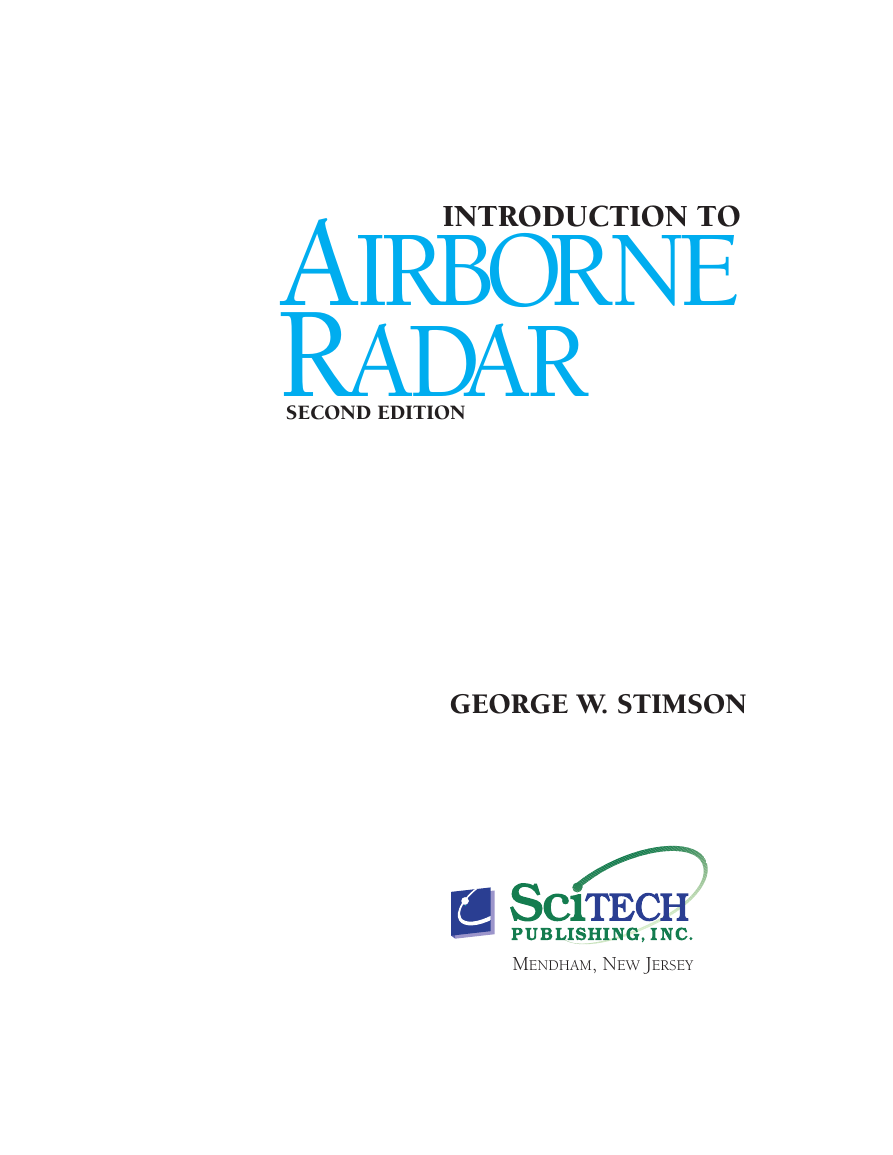
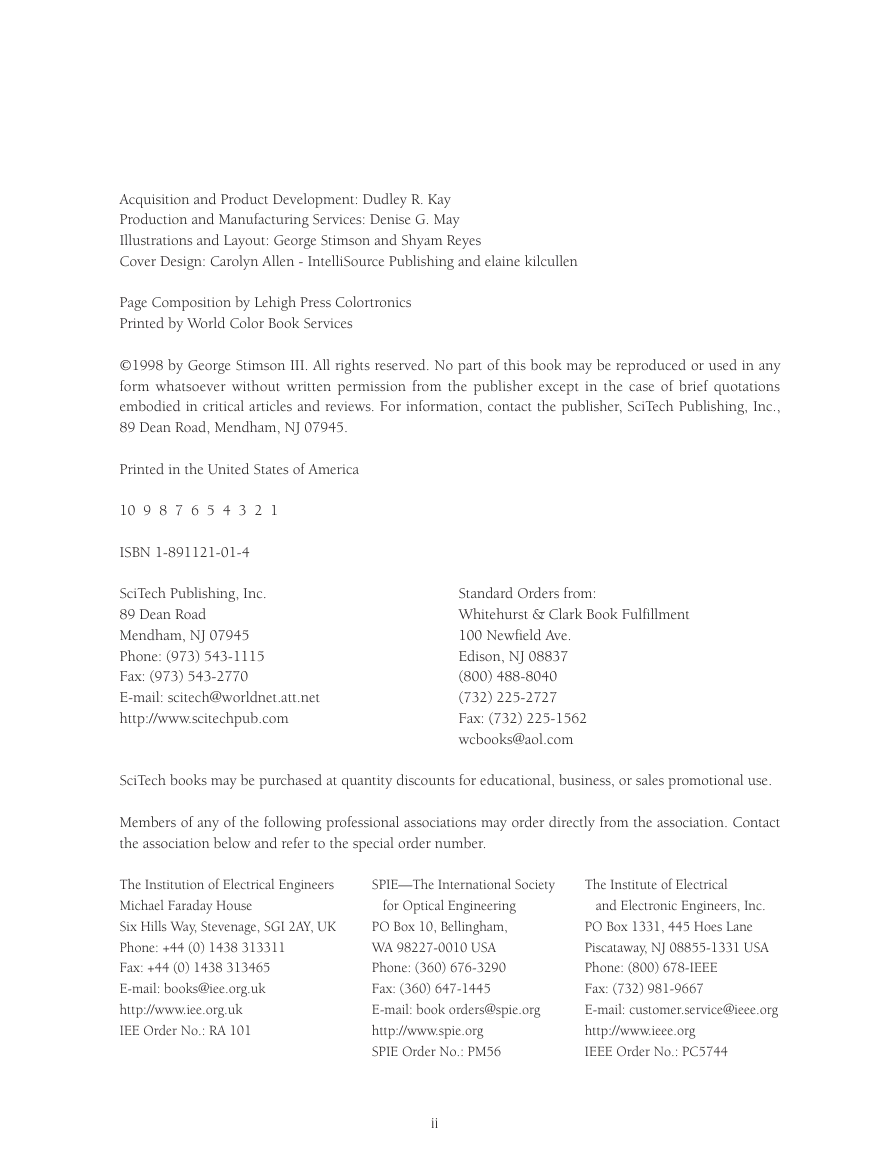
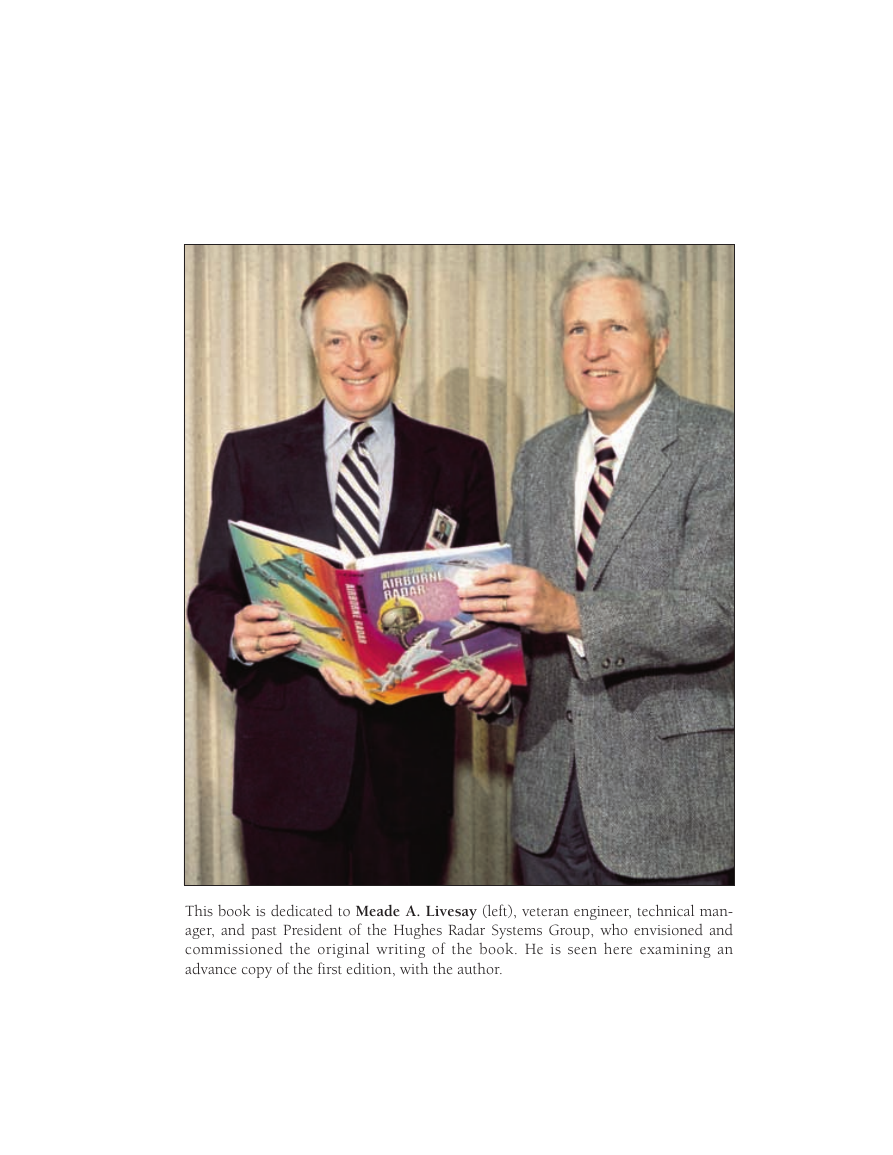

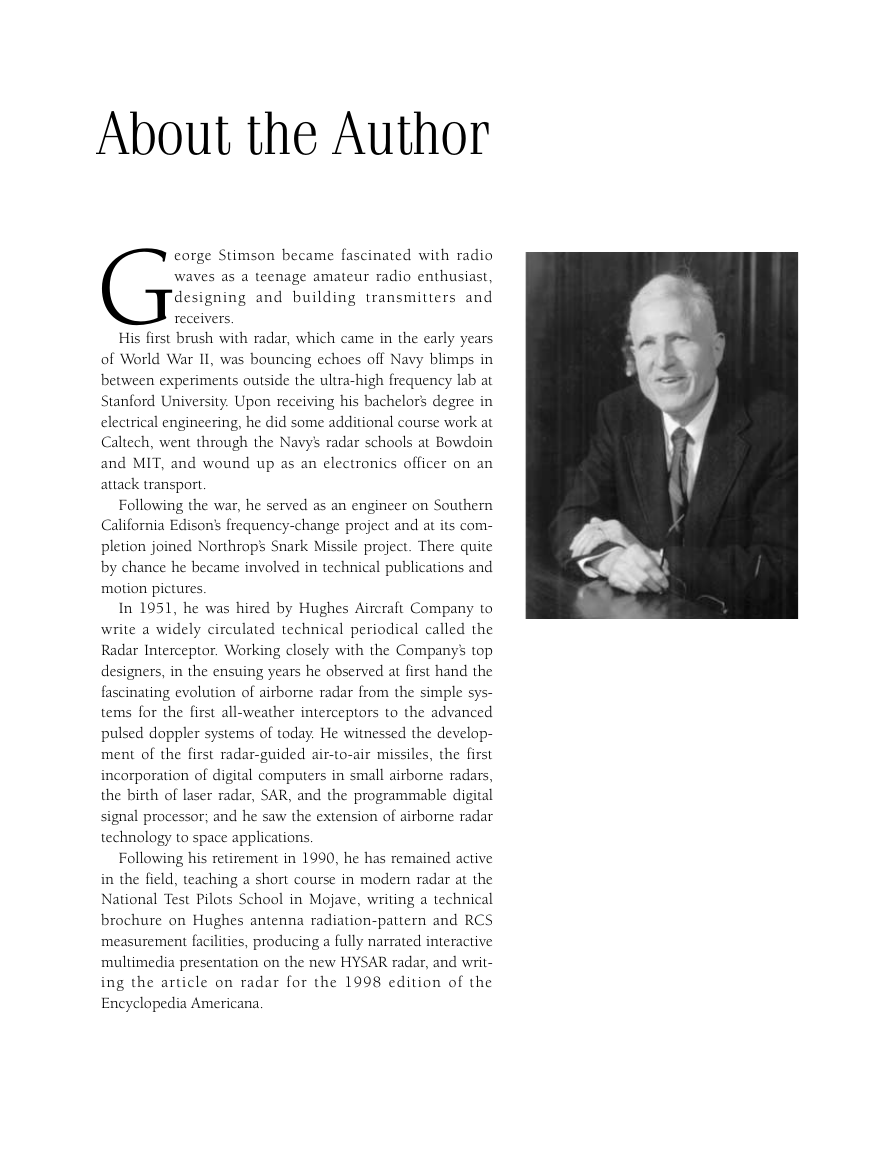
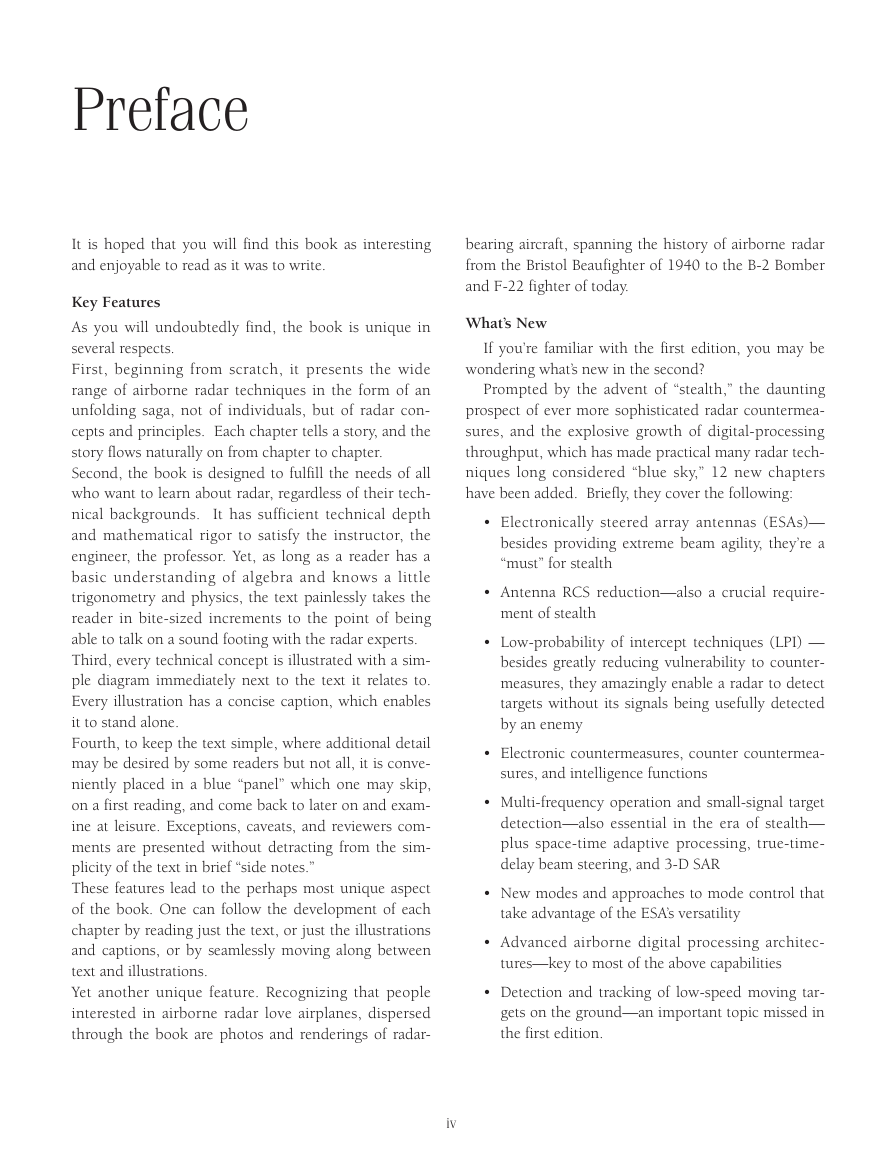
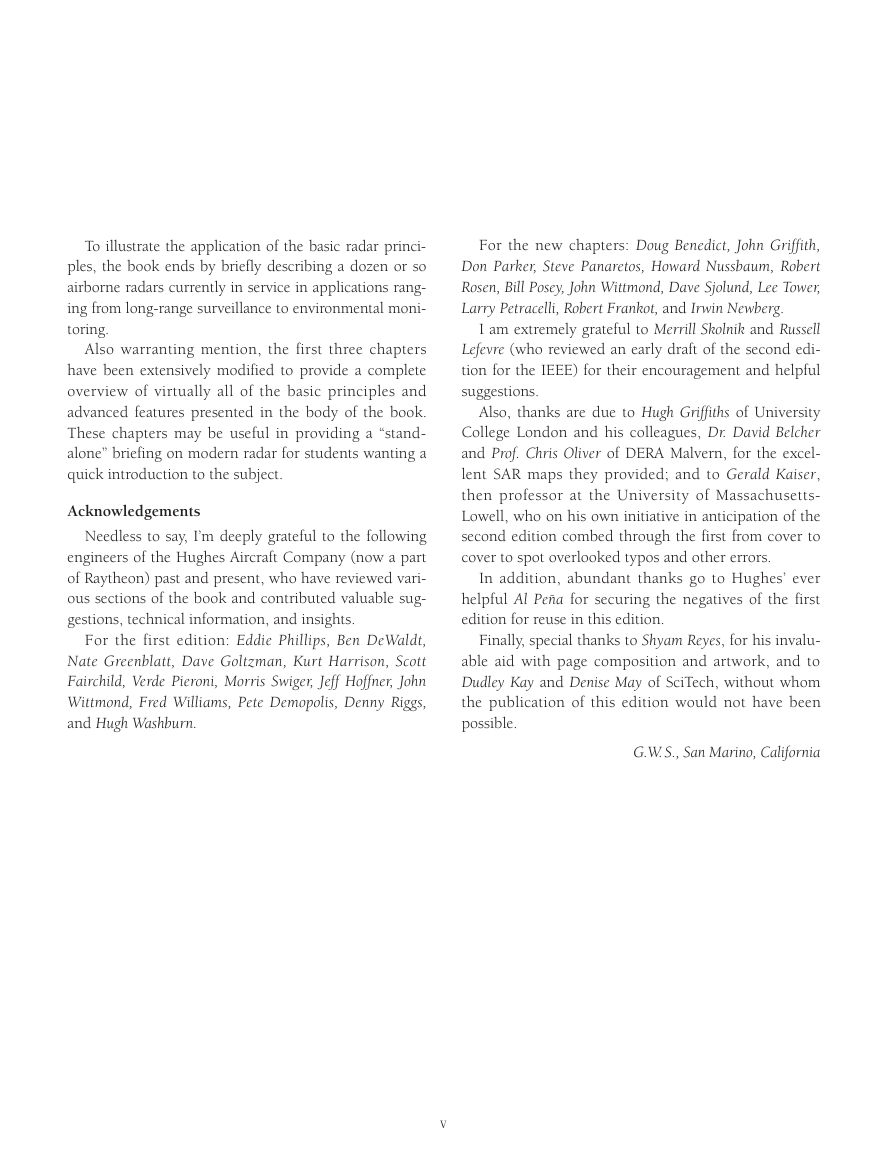
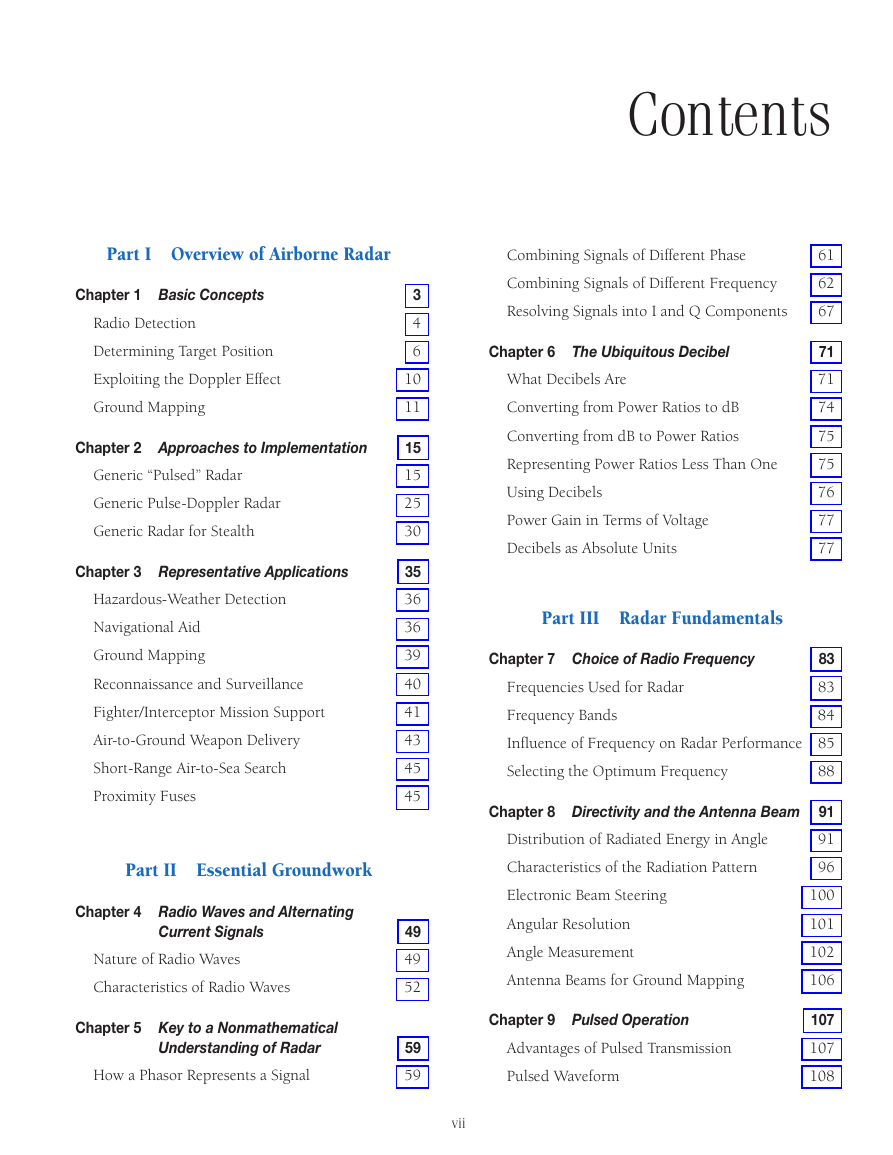








 2023年江西萍乡中考道德与法治真题及答案.doc
2023年江西萍乡中考道德与法治真题及答案.doc 2012年重庆南川中考生物真题及答案.doc
2012年重庆南川中考生物真题及答案.doc 2013年江西师范大学地理学综合及文艺理论基础考研真题.doc
2013年江西师范大学地理学综合及文艺理论基础考研真题.doc 2020年四川甘孜小升初语文真题及答案I卷.doc
2020年四川甘孜小升初语文真题及答案I卷.doc 2020年注册岩土工程师专业基础考试真题及答案.doc
2020年注册岩土工程师专业基础考试真题及答案.doc 2023-2024学年福建省厦门市九年级上学期数学月考试题及答案.doc
2023-2024学年福建省厦门市九年级上学期数学月考试题及答案.doc 2021-2022学年辽宁省沈阳市大东区九年级上学期语文期末试题及答案.doc
2021-2022学年辽宁省沈阳市大东区九年级上学期语文期末试题及答案.doc 2022-2023学年北京东城区初三第一学期物理期末试卷及答案.doc
2022-2023学年北京东城区初三第一学期物理期末试卷及答案.doc 2018上半年江西教师资格初中地理学科知识与教学能力真题及答案.doc
2018上半年江西教师资格初中地理学科知识与教学能力真题及答案.doc 2012年河北国家公务员申论考试真题及答案-省级.doc
2012年河北国家公务员申论考试真题及答案-省级.doc 2020-2021学年江苏省扬州市江都区邵樊片九年级上学期数学第一次质量检测试题及答案.doc
2020-2021学年江苏省扬州市江都区邵樊片九年级上学期数学第一次质量检测试题及答案.doc 2022下半年黑龙江教师资格证中学综合素质真题及答案.doc
2022下半年黑龙江教师资格证中学综合素质真题及答案.doc